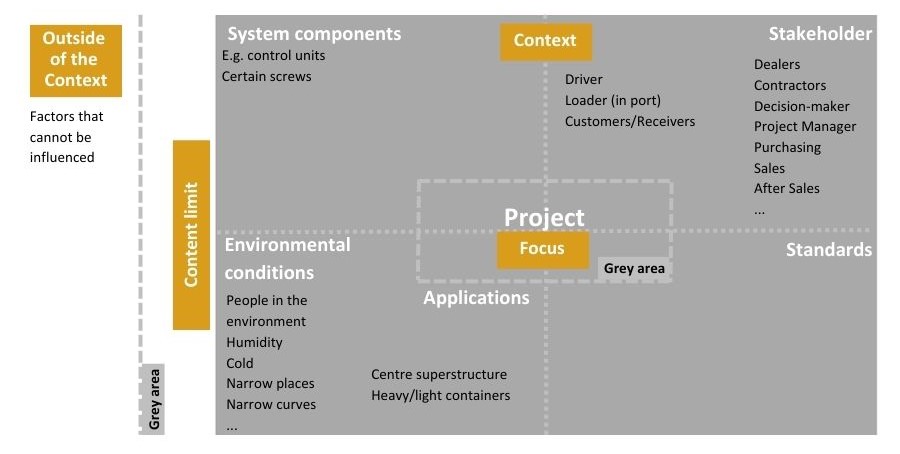Context diagram
The context diagram is a visualisation method that identifies the interfaces of all stakeholders involved in the development process. The components/systems to be integrated, legal foundations, standards and application situations are recorded.

When you develop a new product in your company, requirements engineering is an essential success factor for the subsequent acceptance of your product by the customers. Requirements management uses needs analyses to ensure that you do not develop your product without the customer in mind and that it does not sell well.
Transparency through visualisation also plays an important role in requirements engineering. Requirements become more understandable and also more comprehensible in the later course of development. The context diagram (KTD) is such a visualisation method. It identifies interfaces of all "stakeholders" involved in the development process, the components/systems to be integrated, legal principles, standards and application situations are recorded. The KTD thus serves to define the scope and the limits of the project in the early analysis phase.
This non-hierarchical representation is often used as a starting point for discussing the requirements. The KTD is particularly valuable in the context of a Requirements Workshop. It helps the participants to gain a common understanding of the product/project and to establish a common focus and a clear delineation of the project context.
The simple and spontaneously comprehensible visualisation of the context allows interdisciplinary project teams to discuss their perspectives and concerns together. This joint exchange ensures mutual understanding among the participants from different functional areas already at the beginning of the project. The identification of critical aspects to be discussed can be documented in the "grey areas" and remain there until final clarification. This lays the foundation for fruitful and effective cooperation.
In addition to the quick clarity about which elements have already been developed and need to be integrated into the product or system - e.g. modules or components - so-called "use cases " can easily be derived from the combination of stakeholder and environmental condition or application. It shows which external factors cannot be influenced, such as laws or standards. It takes into account which environmental influences have to be considered as well as which stakeholders are involved and which factors outside the context are not relevant for the development project.
Are you interested in a requirements workshop?
Ihr Nutzen
- Interdisciplinary teams get a rough overview of the project context in a relatively short period of time
- The project scope is simplified in a comprehensible and understandable way
- Errors or contradictions are identified at an early stage so that risks and costs are minimised
- Discussion points become apparent in the "grey zone
- Requirements can be easily derived with use cases from the combination of stakeholder and environmental condition or application

